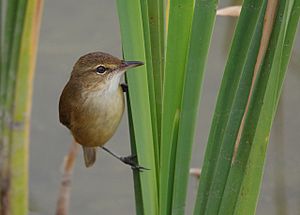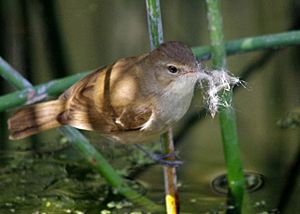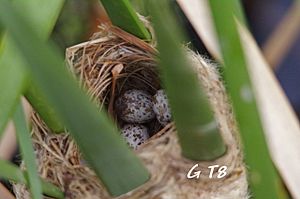Australian reed warbler facts for kids
Quick facts for kids Australian reed warbler |
|
|---|---|
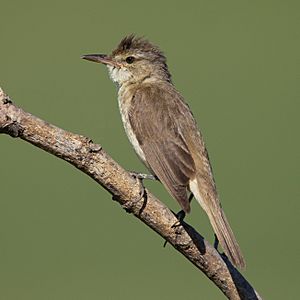 |
|
| Conservation status | |
| Scientific classification | |
| Genus: |
Acrocephalus (bird)
|
| Species: |
australis
|
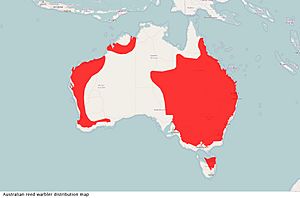 |
|
| Distribution of Australian reed warbler (Acrocephalus australis) shown in red | |
The Australian reed warbler (Acrocephalus australis) is a small, plain brown bird. It belongs to a group of birds called Old World warblers. This bird is special because it's the only type of Acrocephalus warbler that lives naturally in Australia. You can also find it in Papua New Guinea and some nearby islands.
The name Acrocephalus comes from Greek words meaning "topmost head." This refers to the slightly peaked shape of the head on these warblers. The word australis is Latin for "southern," which points to its home in Australia. In some parts of Western Australia, local Aboriginal people call it "Koordjikotji," pronounced core’chee’caw’chee.
Contents
About the Australian Reed Warbler
The Australian reed warbler is part of a large bird family called Sylviidae. This family includes many small to medium-sized birds. The Acrocephalus group, which the Australian reed warbler belongs to, has many species. Scientists have studied their DNA to understand how they are related. The Australian reed warbler's closest relative is thought to be the Caroline Islands reed warbler.
Types of Australian Reed Warblers
There are two main types, or subspecies, of the Australian reed warbler:
- Acrocephalus australis. australis (Gould, 1838) - This type lives in East and South East Australia, including Tasmania.
- Acrocephalus australis. gouldi (J.C. Dubois, 1901) – This type is found in North and South West Australia. It has darker feathers and a slightly longer, stronger beak. It is also a bit bigger overall.
What Does the Reed Warbler Look Like?
The Australian reed warbler is a long, slender bird, usually about 15 to 18 centimeters (6 to 7 inches) long. Its feathers are a dull brown color. The tips of its wings look short because they don't reach far down its back.
Its beak is long and thin, about 1.7 to 2.3 centimeters (0.7 to 0.9 inches) long. It curves slightly downwards with a small hook at the end. Both male and female birds look the same.
When their feathers are new, they are a reddish-brown color from their head down to their back. Their tail feathers are also reddish-brown. The underside of their body is a duller reddish-brown, with white feathers on their throat and chin. They have a faint light brown stripe above their eye. The feathers on their head can stand up a bit, forming a small crest when they sing. Young birds look very similar to adults.
The Reed Warbler's Song
The Australian reed warbler has a loud and varied song. It's described as a sweet, musical warble with clear, flute-like notes. It also includes some harder, metallic sounds.
The song is made of short patterns of sounds that are repeated. After a few seconds, different combinations of sounds are repeated. Scientists believe that males use their song to show how strong and healthy they are to females and other males. They also use it to mark and protect their breeding areas.
Where Do Reed Warblers Live?
Australian reed warblers live in many different wet places. This includes natural wetlands and places made by people, like ponds or dams. They can be found in fresh, salty, or slightly salty water environments.
They especially like dense plants that grow tall and straight. These include reeds (like Phragmites), reedmace (Typha), and rushes (Juncus). You often see them perched sideways on a reed stem. Sometimes, they are also seen in shrub lands and forests near water, where they look for food.
How Reed Warblers Live
What Do They Eat?
These birds mostly look for food alone, but sometimes in pairs. They eat insects and spiders found in thick plants. Occasionally, they also eat snails or seeds. They search for arthropods (like insects and spiders) among the plants near water and in nearby shrubs and woodlands. Sometimes, they even look for food on open mud near reeds.
How Do They Breed?
Australian reed warblers form pairs for one breeding season. Both the male and female build the nest and feed the chicks. They usually don't pair up with the same bird in the next season.
Unlike most other Acrocephalus species, the Australian reed warbler moves to different areas for different seasons. They travel to South West and South East Australia to breed. They spend the winter in Eastern and Northern Australia. Males arrive at the breeding areas first, usually from July to August. The breeding season is from October to December in south-eastern Australia, and from September to December in southern Australia.
Both parents build the nest, but the female does more of the work. The nest is a deep cup shape, made from dead and fresh plants. It's usually supported by reed stems, about 30 to 200 centimeters (1 to 6.5 feet) above the ground or water.
The female sits on the eggs for 13 to 15 days. A female usually lays 2 to 4 eggs. Both parents feed the chicks in the nest for 10 to 13 days. They continue to feed the young birds outside the nest until they are about 28 to 29 days old. About 58% of nests are successful. The biggest reason for nests failing is predators eating the eggs or chicks.
Courtship and Nesting
Male reed warblers arrive at the breeding sites before the females. They do this to set up their breeding territory. During the breeding season, males sing a lot to show other males and females how strong they are. They often sing while perched on reeds, with their head feathers slightly raised and throat feathers puffed out.
While males and females build the main nest for eggs and chicks, males also build other nest-like structures during courtship. These structures are not strong enough for eggs or chicks. They are built before the main breeding starts. This behavior is thought to help males attract a mate and choose a good breeding territory.
Threats to Reed Warblers
The Australian reed warbler is at risk when its habitat is destroyed. This can happen if wetlands are burned, cleared, or drained. These actions remove the reeds and other plants the birds need.
Migratory birds in south-east Australia are also changing when they arrive and leave their breeding grounds. This is happening because of climate change. Scientists are still learning how much these changes affect the Australian reed warbler.
See also
 In Spanish: Carricero australiano para niños
In Spanish: Carricero australiano para niños



